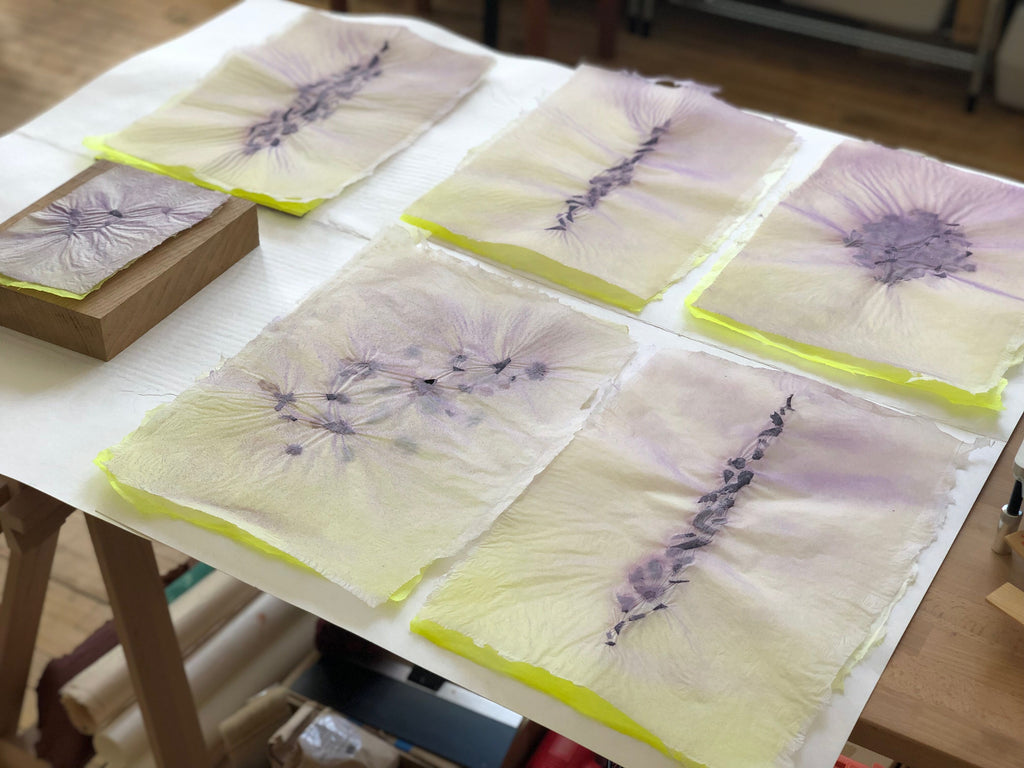JEAN BRENNAN, ARTIST


Jean Brennan, Artist, Wears Colorant Hand Painted Jumpsuit in silk charmeuse, brush painted with crushed Cochineal & Fustic natural dyes.
Orsallia, a natural red purple dye, is an extraction from the lichen Umbilicaria which was worn by nobility in Roman times to display wealth, power and status. Women were forbidden to take part in the creation of this dye and ordinary citizens were forbidden to wear it. Ancient recipes include ocean water and urine in the dye process and it was often used in place of the Murex mollusk, a sea shellfish, a source of a similar royal hue but not as easily collected.
Blue.
Describe a typical day of your studio practice.
My day to day varies, from teaching to writing grants to messing around in the studio. Projects often begin with walks and writing, coupled with research about a plant or a place. In my response to site, I’m often weaving in scientific research, historical references, pop culture. Sometimes the relationships with scientists or collaborators, human or non-human, become central to the work.
Who are you currently inspired by? An eclectic group of women: Amy Franceschini from Future Farmers, Agnes Denes, Helen Mirra, Donna Haraway, Joan Jonas, Rebecca Horn.
Describe ‘Performing vowels in the note of blue’ & the process in how the project came together.While visiting Michigan one summer, I was struck by the endless miles of reforestation, a mesmerizing repetition of red pines flying past the car window. Eventually, I found a location maintained by the University of Michigan Biostation, with little undergrowth save a patchy carpet of spring ferns. I staged a few photos and the seed for 'Performing vowels in the note of blue' was planted. That Fall, I located a similar site in my home state of New York.
'Performing vowels' is a score of non discursive communication filmed with(in) a grove of red pines in the Catskills. Planted by the Civilian Conservation Corps during FDR's New Deal, this century-old stand possesses the uncanny quality of a single species plantation gone wild. Standing among the trees, five women (a,e,i,o,u) perform the vowels through the use of semaphore flags- a signaling system that augments the body to communicate over the distances of land and sea. The movements, like language and the forest, slip between structure and improvisation. In this 8 minute video, looped in a gallery setting, I imagine a form of communication in which the forest plays a role in how we transmit ideas—a ritual of call and response whereby the patterns of movement and non-verbal sound form the phrases of language.
The original action was inspired by research on how trees 'talk' and asks if there are example of human communication that come closer to the way non-humans, such as plants and animals, communicate. That's how I arrived at the idea of using semaphore flags. But in the making of Performing Vowels, all kinds of other meaning began to unfold. For instance, vowels are the breath of language- in a sense they are atmospheric. Vowels are a speech sound that is made with no obstruction of the vocal tract, frictionless and continuant, they are open-throated. The color blue corresponds to the throat chakra and to truth. In Judaism, vowels are associated with god; in Japan, with the mother.
Click to view Performing vowels in the note of blue
Favorite trails to Hike?
Fishkill Ridge, east of Mount Beacon; Mohonk Preserve in the Catskills; and, Mt. Lafayette in the White Mountains.
Describe the process in how you conceived Intergalactic Naval Gazing?
It began with walking, plant identification, and dye research at the Haystack Artist Residency on Deer Isle, Maine (May 2018). Later that summer, on a hike in the Catskills I came across a large rocky outcrop covered with the Umbilicate mammulata lichen, known as rock tripe. In Latin, umbilicate refers to the naval, while mammulata, means small breast. I was drawn to the bodily references, as well as the deep purple dye it yields, called orsallia. A storm had detached and blown lichen bits all over the ground so I was able to gather a good amount. I chopped these up into smaller pieces and placed them in mason jars. The jars, marked either Y.O.U. (your own urine) or A.M. (ammonia method), sat in a window by my dresser. Each morning and evening, I gave the jars a hearty shake - for 4 months.
All lichen are symbiosis of algae and fungi, an unexpected marriage of producer and de-composer. Using my own bodily fluids, and cohabiting with these jars as they transformed, was a way to enter into this synergy. The dye was ultimately displayed in flame-work glass vessels fabricated by Dan Spitzer from Malfatti Glass according to sketches I made while looking at medical renditions of internal organs. I wrote the essay, Intergalactic Naval Gazing, as an ode to the lichen I foraged.






